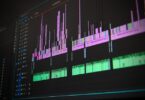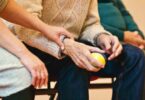aNewDomain.net — Run, do not walk, to catch the David Hockney exhibit at San Francisco’s de Young Museum through January 20th.
Hockney, the world famous British artist, has always been interested in the effects of technology on art. In case you can’t make it to San Francisco to see David Hockney: A Bigger Exhibition, here’s a taste of the brilliant work by an artist who keeps on exploring new ways to express himself.
[acx_slideshow name=”David Hockney Exhibit”]
Many artists eschew technology in the production of their works, calling the use of photos or tablets or projectors “cheating.” That’s not the case with the 76-year-old Hockney. An early user of technology (sometimes including Polaroid photography as part of the art process), Hockney progressed to smartphones and tablets to become a highly-recognized iPad artist with several iPad-created covers commissioned by The New Yorker magazine.
When I think of David Hockney, I recall his almost naïve portraits, landscapes and still lifes in bright mid-century colors. Hockney was born in England in 1937, but he called southern California his home for 30 years. Later, he would return to his native England in 2006. The current exhibit at the de Young museum shows the prodigious work of Hockney, whose talent was recognized even as student, and who was among those heralded at the start of the British Pop Art movement.
Hockney praises the iPad, which he finds handy for fast sketches as well as final works and particularly useful for creating luminous subjects and differentiating one surface from the next. I could see Hockney’s process in a darkened room in the middle of the exhibit featuring multiple electronic displays of his tablet-based work including a still life of oranges in a bowl. Using a stylus and the Brushes app, you watch Hockney’s brushstrokes advance through his painting. It continues to develop, and you watch Hockney’s aesthetic decisions, and witness how the detail evolves. Brushstrokes appear then disappear, highlights become more evident and shadows give even-finer shape to the fruit as Hockney refines the piece. Like the classically-trained artist he is, he begins with the basics, establishing his range of tones, and then he digs in, adding richness and dimension.
Hockney thinks big. He knows the images will be printed five feet high. And some of his iPad prints are more than 10 feet tall. The iPad gives artists a direct, immediate medium to sketch or even create complete works. “You can speedily establish color palettes,” notes Hockey. The device is obviously an important tool for him and allows him to capture the ever-changing seasons of the English landscape.
Hockney works hard and he works fast. I find that his portraits seem hasty, many completed in a matter of a couple of days. They isolate the figure from a starkly-simple background, and in doing so I had an intimate undistracted connection with his subject.
In contrast, I found a way to appreciate Hockney’s depth and patience in his easygoing depictions of the Yorkshire countryside. His attention to detail to trees, pathways, and sunlight can be seen over and over again as the seasons change.
In interviews, Hockney admits how California sunshine had an effect on his paintings of East Yorkshire. And similarly how the lack of seasons in California heightened his sensitivity to the Yorkshire countryside. In direct contrast to the rooms filled with brightly-colored landscape paintings, one room at the de Young exhibit is devoted entirely to Hockney’s charcoals of the English countryside — sketch after sketch after sketch of different seasons and settings.
The last room of the exhibit is “The Big Wall,” the first public display of a 72-foot-long eight-foot-high chronological art display. It’s Hockney’s challenge to popularly-held beliefs that artists throughout history did not use technology or cheat as some might think. Five hundred and fifty images ranging from the years 1350 to 1900 line the walls. Around 1425 to 1435 there was a distinct shift in Western art from flat portraits to more-natural, looser poses. Hockney maintains that artists had a secret helper in the form of the camera obscura. Records of camera obscura technology go back to Arab physicist, Ibn Al-Haytham’s (965 – 1040) work in optics. In the book Secret Knowledge: Rediscovering the Lost Techniques of the Old Masters Hockney looks at the old masters and, along with physicist Charles M. Falco, shows that indeed there are distortions in some of the classic works. This reveals there are distinct signs that some optical aids were at play. Is this cheating? I think not.
Hockney is prolific and, like the show itself which is the largest exhibition in the history of the de Young Museum, he thinks big, creating plein air landscapes using six canvases at once. He is fascinated by the effect of, and use of, technology in art (in one interview he mentions that Impressionism would not have been possible without the collapsible oil paint tube). One wall in the exhibit is dedicated to his multi-panel flatscreen video display that explores a sort of cubism. It lands the viewer in the middle of a stage of jugglers, but the viewer sees more than a normal field of vision. Could a portrait of Schrodinger’s cat be next?
Further Information:
M.H. de Young Museum
Golden Gate Park
50 Hagiwara Tea Garden Dr.
San Francisco, CA 94118
deyoungmuseum.org
415-750-3600
Museum Hours:
Tuesday–Sunday, 9:30 am–5:15 pm
Closed Mondays
Tickets start at $25 for adults and include general admission; discounts are available for seniors, students, and youths. Special Premium tickets are also available. Members and children five and under are free. Tickets available at deyoungmuseum.org. Prices subject to change.
For aNewDomain.net, I’m Pat Meier.













beautiful
-RAP, II